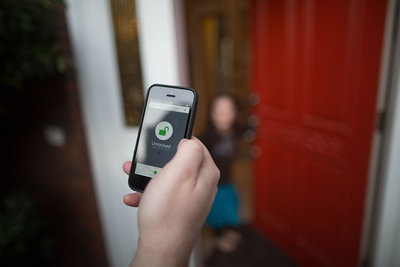
The iconic space-age cartoon The Jetsons features a technologically advanced home, complete with a robot housekeeper and a home full of futuristic gadgets. The show first aired in 1962, and while houses still don’t brush your teeth for you or make breakfast with the press of a button, technology now enables us to do some advanced home control, like dimming your living room lights from miles away.
Home automation systems have arrived. Along with compost, urban gardens and solar panels, they’re the future of sustainability.
These systems let you put all appliances on a schedule, offering unlimited possibilities. You can see who’s at your door on your TV screen, or you can tell your system to shoot you an email when it detects motion while nobody is home. In addition to peace of mind, automation can provide notable energy savings over the long run.
How they work
The goal of home automation systems is basically to get your devices to “talk” to each other; a central controller, or hub, often facilitates the communication among devices. Control4 is a popular hub brand that acts as the brain of the house, keeping track of all the automated components, says Gordon Handley, owner of Portland Home Automation.
The three biggest players in home automation systems are Insteon, Z-Wave and Zig-Bee. Each works in similar ways but uses its own language.
Having a hub isn’t necessary if you only have a single automation device — individual setups can be as simple or as complex as you want, whether you want to turn off the basement light from your bed or trigger your favorite song to play as you walk in the door.
“Home automation systems can do so many things,” Handley says. “You can pretty much make it do anything.”
Modern home automation systems are fairly secure, though there is a risk any time you connect to the internet. For a thief, it’s much easier to break a window than to take the trouble to hack in and turn your stereo on.
While devices for the most simple automation systems — light switches, for example — start at $35 to $50, a fully automated home can easily reach $2,000 to $3,000.
Lighting
Welcome to the light switch of the future. No more fumbling around in the dark to turn on the hall light. Honeywell, a producer of commercial and consumer products, allows you to automate your lights from your bed.
Lights can be programmed to turn off at a certain time of the day, or when someone enters and leaves a room. You can program porch lights to turn off at a certain time of night. Leviton, an electrical wiring equipment company, sells switches and dimmers that let you dim your light bulbs. Kwikset offers locks that can work with Z-Wave technology to turn on lights when you walk in the door. The Kwikset Z-Wave locks are created to unlock and lock with your phone or a keypad, and they allow multiple user codes to let the hub know who has arrived home.
Water
Several home automation companies offer irrigation control, such as Insteon and RainMachine, which can connect to weather reports from the National Oceanic and Atmospheric Administration to automatically adjust sprinkler use based on how often it rains. To save energy and money over time, the Insteon Wireless Water leak sensor will detect if there’s a leak in your pipes and send you a text before any flooding or damage occurs.
 |
|
Adam Becker demonstrates using the Nest thermostat with a smart phone. Photo by Amanda L. Smith
|
Heating
According to energy.gov, heating and cooling costs make up to 48 percent of residential utility bills; home automation systems can cut cost and energy use. Synco lets you program thermostats to operate on a different heating or cooling schedule according to the day of the week.
Eugene resident Adam Becker installed a Nest thermostat in his home, which “encourages you to save energy by working with the weather,” he says.
Similar to irrigation systems, the thermostat connects to the weather forecast so it can tailor settings to match the temperature without you having to turn it up manually. When Nest senses there is no movement in the home, it can adjust the heat to save energy. At the end of the month, you receive a monthly report telling you how much energy you saved.
Somfy offers internal motors, used by many window-covering manufacturers, with an interface module for home automation systems allowing you to dictate when window shades go up and down, perhaps at peak sunshine hours, to more naturally heat the home.